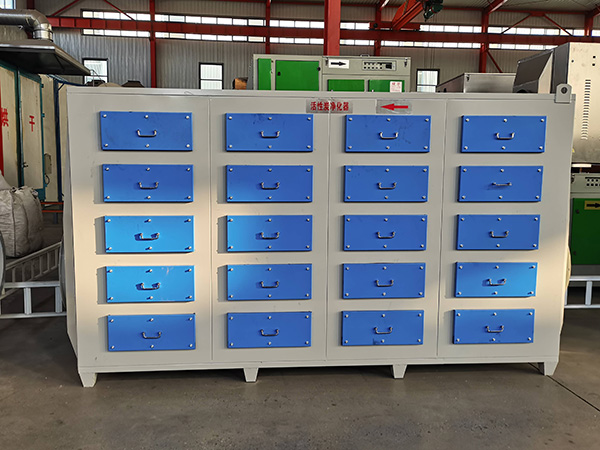-
All
-
bag Dust Collector
-
Electrostatic Precipitator
-
Cartridge Dust Collector
-
Desulfurization And Denitrification Equipment
-
Dust Collector Bag
-
Dust Collector Skeleton
-
Electromagnetic Pulse Valve
-
Rotary Valve
-
Screw Conveyor
-
Dust Conditioner
-
Plug Valve/Butterfly Valve
-
Scraper Conveyor
-
Catalytic Oxidizer
-
Cyclone Dust Collector
-
Sintered Plate Dust Collector
-
Spray Tower
-
Activated Carbon Adsorber
-
Light Oxygen Purifier
-
Dry Filter Box
-
Bucket Elevator

Activated Carbon Purifier
The core advantages of activated carbon purifiers are strong adsorption capacity, wide range of application, and easy operation....
The core advantages of activated carbon purifiers are strong adsorption capacity, wide range of application, and easy operation, which can not only provide solutions for organic waste gas treatment in industrial production, but also improve the air quality of confined spaces such as homes and offices, and is a basic purification device that is widely used in the field of environmental protection. From the perspective of structural design, the core components of the two types of purifiers are the same, both include inlet air filtration unit, activated carbon adsorption unit, airflow guidance unit, and outlet unit, but the detailed design is adjusted according to the difference in scenes. Industrial-grade activated carbon purifiers mostly adopt a modular box structure, and the box material can be carbon steel (anti-corrosion coating), stainless steel or PP, which is suitable for different industrial exhaust gas environments. The intake air filter unit is equipped with primary and medium filters to block impurities such as dust and oil mist to avoid clogging the activated carbon pores. The adsorption unit is filled with columnar and honeycomb activated carbon (the specific surface area is usually > 1000㎡/g), and some high-end models will be equipped with catalyst coating to improve the decomposition efficiency of organic pollutants. The airflow guide unit passes through the deflector or fan to ensure that the gas passes evenly through the adsorption layer. The civil-grade purifier is mainly miniaturized and portable, the body is mostly made of ABS plastic, and the size is small (common size 30-50cm), and the adsorption unit mostly uses activated carbon filters, some will combine HEPA filters, and are equipped with intelligent control panels that can display air quality and operating status in real time. Its working principle is based on the "physical adsorption + chemical assistance" mechanism: after the gas containing pollutants enters the purifier, the large particles and impurities are first removed through the intake filter unit; then the airflow enters the activated carbon adsorption unit, and the rich micropores and mesopores on the surface of the activated carbon generate adsorption, capturing and fixing harmful components such as organic waste gas (industrial scene), odor, formaldehyde, TVOC (civil scene), etc.; the purified gas is discharged through the gas outlet unit. Some industrial-grade models also have desorption and regeneration functions, which can release the adsorbed pollutants by heating or passing through inert gas, so as to realize the recycling of activated carbon; the civil grade needs to replace the activated carbon filter regularly to ensure the purification effect. Compared with other purification equipment, activated carbon purifiers have outstanding advantages: they are widely applicable to various scenarios, industrial grade can treat VOCs exhaust gas in spraying, printing, chemical and other industries, and civil grade can improve the air quality of homes, new cars, and offices; good purification effect, industrial grade for medium and low concentration (50-1000mg/m³) VOCs removal rate reaches 85%-90%, civilian grade for formaldehyde and odor removal rate of more than 80%; easy operation, industrial grade can achieve automatic operation through PLC control system, civil grade only needs one button to start and stop, filter replacement is simple; the cost is moderate, the initial investment of equipment is lower than that of catalytic combustion, RTO and other industrial equipment, and the unit price of civil grade is mostly a few hundred to several thousand yuan, which is cost-effective. However, it should be noted that industrial-grade waste gas treatment with high concentrations (>1500mg/m³) needs to be pretreated to avoid rapid saturation of activated carbon; the civilian grade needs to replace the filter regularly according to the area and pollution level (usually 3-6 months); Both types of equipment need to control the gas temperature (industrial grade <40°C, civil grade normal temperature) and humidity (relative humidity <80%) to prevent the adsorption efficiency from decreasing. Overall, activated carbon purifiers occupy an important position in the fields of industrial environmental protection and civil air improvement due to their flexible adaptability and stable purification effects, providing reliable solutions for gas purification needs in different scenarios.







